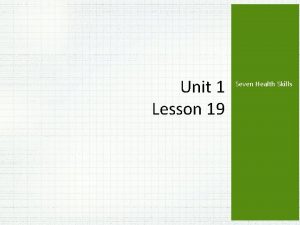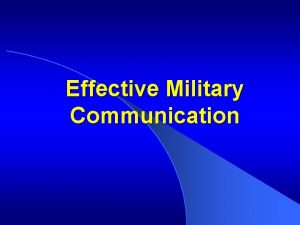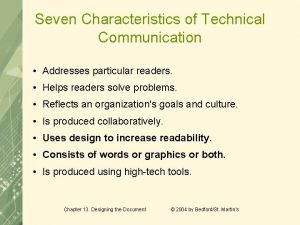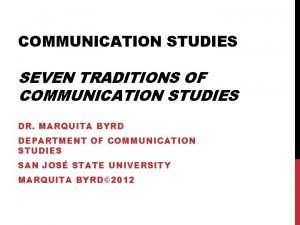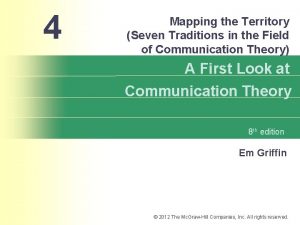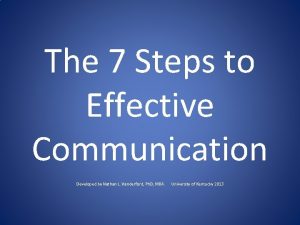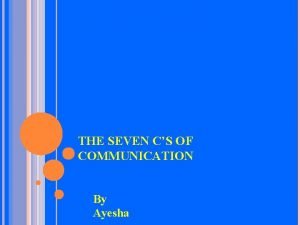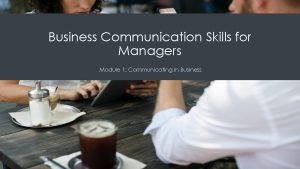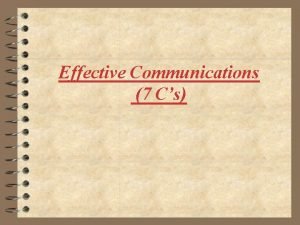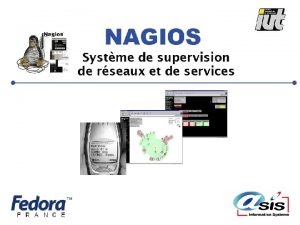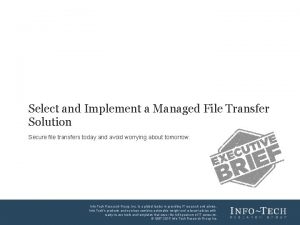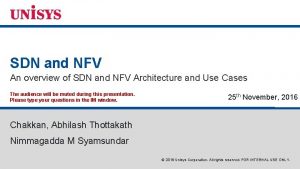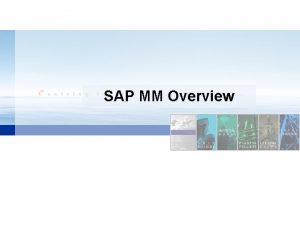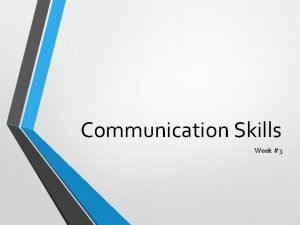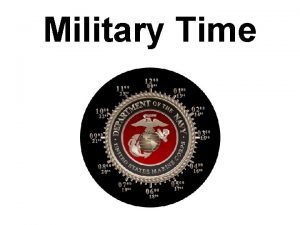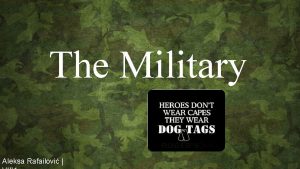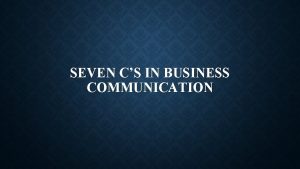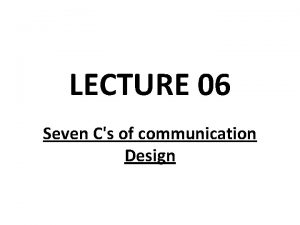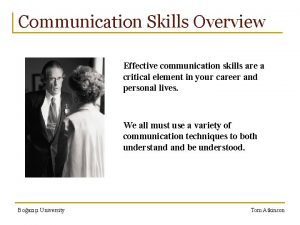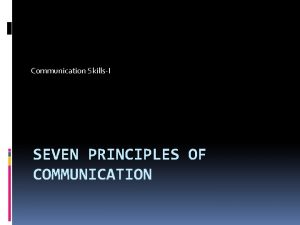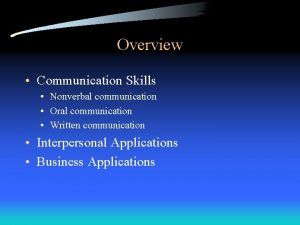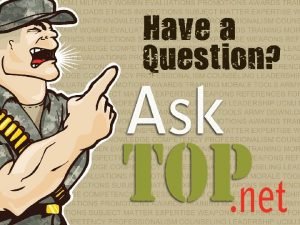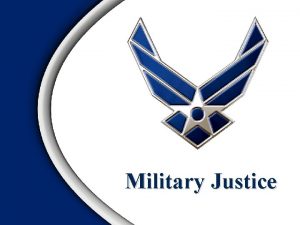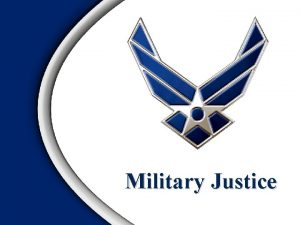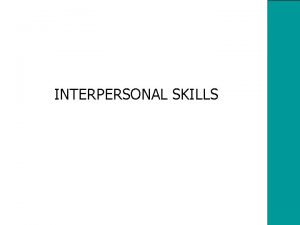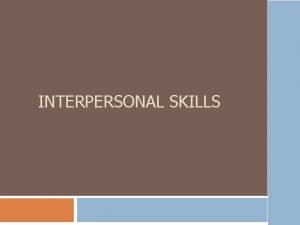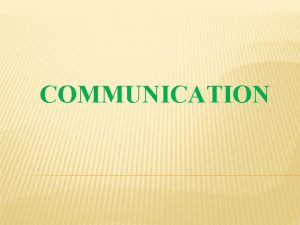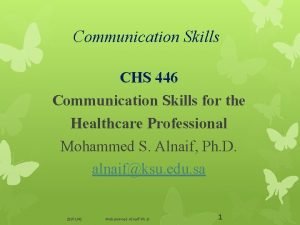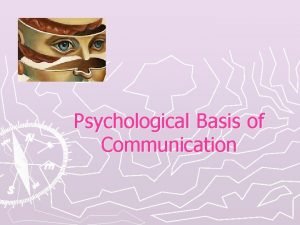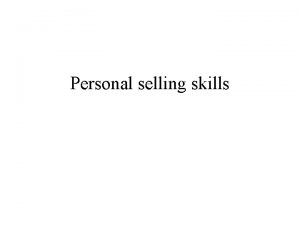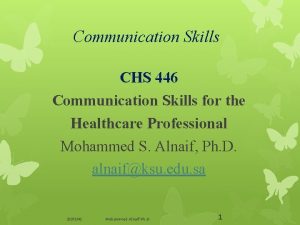Military Communication Skills Overview Military Communication Skills Seven

















![Electronic Communication • Official e-mail example: [Greeting], Ex: Good morning Sir/Ma’am, Effective 29 Oct Electronic Communication • Official e-mail example: [Greeting], Ex: Good morning Sir/Ma’am, Effective 29 Oct](https://slidetodoc.com/presentation_image_h/791477e3a5d2fdd1b6da5d6555ee6594/image-18.jpg)












- Slides: 30

Military Communication Skills

Overview: Military Communication Skills • Seven Steps to Effective Communication • Talking Paper, Bullet Background Paper & Memorandum for Record • Electronic Communication • Briefings

Military Communication Skills Time well-spent in preparing for any type of writing or briefing pays big dividend$. You’ll feel CONFIDENT when speaking. Your message will have CREDIBILITY. The 7 steps for effective communication offers you CONFIDENCE and CREDIBILITY!

Overview: Military Communication Skills • Seven Steps to Effective Communication • Talking Paper, Bullet Background Paper & Memorandum for Record • Electronic Communication • Briefings

Seven Steps 1. Analyze your purpose and audience – Purpose? – Audience? • • What will make it easy for your audience to understand? Be inclusive (use words meaningful, respectful) • Ex: I’m looking for a committee chairman for the December food drive… • use “chairperson”

Seven Steps 2. Research your topic – Sources? – Personal bias? – Other perspectives to study?

Seven Steps 3. Support your ideas • Cite Sources • Offer Evidence (definitions, examples, statistics, basic assumptions, explanation) • Use Logical, Rational Arguments (T&Q pg. 42 -53) q All humans are mortal. q Socrates is human. q Therefore, Socrates is mortal.

Seven Steps 4. Organize and outline • Outline your main ideas • Pick your organizing pattern: TOPICAL COMPARISON-CONTRAST CHRONOLOGICAL SEQUENTIAL SPATIAL PROBLEM-SOLUTION REASON/LOGIC CAUSE-EFFECT PRO-CON

Seven Steps 5. Draft • Written: Intro-Body-Conclusion • Briefing Notes/Slides: Overview-Body-Summary Grammar Jargon √ Writing Mechanics Wordiness Spelling Keep it simple!

Seven Steps 6. Edit (See T&Q, p 91) – Do your own edit first…w/FRESH eyes! – Find another set of eyes! – “Be one with your audience” – Start w/the BIG PICTURE…then the details Proof-Redo…Proof-Redo

Seven Steps 7. Fight for Feedback and Get Approval – Seek out another set of “eyes” – Have feedback givers focus on: • Clear purpose? • Fits my audience? – Feedback comes in 3 flavors: • Necessary? • Desirable? • Unnecessary? For more information on the 7 Steps, see Ch 2 -9 in your T&Q

Overview: Military Communication Skills • Seven Steps to Effective Communication • Talking Paper, Bullet Background Paper & Memorandum for Record • Electronic Communication • Briefings

The Talking Paper Definition: a quick reference or outline for a program, problem, biography, or oral presentation. Flexible use! TALKING PAPER ON NEW AIR FORCE LIEUTENANTS - The new Lt has “potential energy” -- Source of fresh ideas -- Hopeful to make a difference - Lts need to learn the military system -- Appropriate channels -- Appropriate documentation Maj Cecil/HOLM CTR/CR/3 -1017/agc/8 Mar 15

The Bullet Background Paper Definition: a paper that provides the background of a program, policy, problem or procedure. Simple format for complex issues. (T&Q, pp 226 -227) BULLET BACKGROUND PAPER ON WRITING BULLET BACKGROUND PAPERS PURPOSE The purpose statement informs readers on both the purpose and main points of the paper. It may be a single sentence or a short paragraph in length. FORMAT Main ideas may be presented as headings (e. g. PURPOSE, DISCUSSION, FINDINGS, RECOMMENDATIONS) - Secondary items follow with a single dash; tertiary and further subordinate items follow with multiple indented dashes CONCLUSION End with recommendations or conclusions that end the discussion. Maj Cecil/HOLM CTR/CR/3 -1017/agc/8 Mar 15

The Memorandum for Record Definition: The MFR is less formal than the official memorandum but records important information, questions or actions quickly. There are several formats for the MFR depending on the time and space available. (T&Q, pp 190 -191) 17 February 2014 MEMORANDUM FOR RECORD SUBJECT: The Memorandum for Record 1. The memorandum for record, commonly known as a memo for record, MR or MFR, has three forms: (a) the separate page memorandum, (b) the explanatory note, and © the compact note. The form used is determined by the purpose for the MR and the needs of the writer. 2. The separate pate MR uses a modified signature block by using the organization abbreviation and office symbol rather than the duty title. Agnes G. Cecil AGNES G. CECIL ACSC/CSS

Overview: Military Communication Skills • Seven Steps to Effective Communication • Talking Paper, Bullet Background Paper & Memorandum for Record • Electronic Communication • Briefings

Electronic Communication • “Netiquette” – rules for electronic communications network – Be clear and concise – Watch your tone – do not write in ALL CAPS! – Be selective about what you send (OPSEC) – Be selective about who gets the message – Check attachments and support material – Use proper format for official email For more information on Email Protocol, see T&Q Ch 12
![Electronic Communication Official email example Greeting Ex Good morning SirMaam Effective 29 Oct Electronic Communication • Official e-mail example: [Greeting], Ex: Good morning Sir/Ma’am, Effective 29 Oct](https://slidetodoc.com/presentation_image_h/791477e3a5d2fdd1b6da5d6555ee6594/image-18.jpg)
Electronic Communication • Official e-mail example: [Greeting], Ex: Good morning Sir/Ma’am, Effective 29 Oct 13, all Air Force Doctrine Documents (AFDDs) have been rescinded and replaced by core doctrine volumes and doctrine annexes. - Core doctrine is categorized into five volumes: Volume I, Basic Doctrine; Volume II, Leadership; Volume III, Command; Volume IV, Operations; and Volume V, Support - Each core doctrine volume is supported by one or more annexes. - For further information, go to https: //doctrine. af. mil/. //SIGNED// WILLIAM B. MITCHELL, Colonel, USAF Director, Doctrine Development Le. May Center for Doctrine Development and Education Voice: DSN 493 -0000 / Comm (334) 953 -0000 FAX: DSN 493 -0001 / Comm (334) 953 -0001 william. mitchell. 1947@us. af. mil SIGNATURE BLOCK Line 1: Name/Rank/Affiliation Line 2: Job Title Line 3: Location Line 4: Phone Line 5: Fax (if applicable) Line 6: Email address NOTE: Do not add slogans, quotes or other personalization to an official e-mail/social media signature block (T&Q, p. 139).

Electronic Communication Quiz __1. Be polite and professional; be careful about humor and sarcasm. __ 2. Often contains slang, doesn’t affect the AF (hopefully), and doesn’t need a signature block. __ 3. Causing congestion on the network by sending inappropriate e-mail messages (e. g. , chain letters) or excessive storage on a server.

Electronic Communication Quiz __ 4. Don’t discuss controversial, official use only, classified, or privacy act info requiring special handling of documents. __ 5. Read and delete unnecessary files daily; sign off the computer when you leave your work station. __ 6. Get permission before using large mail groups; use “reply all” very carefully. __ 7. Use includes communications the AF determines necessary in the interest of the Federal Gov’t.

Electronic Communication Quiz __8. Use includes personal e-mail approved by the “agency designee. ” __ 9. Using someone else’s User. ID or password w/o proper authority. __ 10. Using email for financial gain or copyrighted info without consent.

Electronic Communication Quiz JUST FOR FUN 1. ____ is a computer that responds to request for information from client computers. 2. Each base has a limited number of _____ which is the number of bits/sec that can be passed along a communication channel in a given period of time. 3. Writing with ALL CAPS is the e-mail version of ____rude email use.

Overview: Military Communication Skills • Seven Steps to Effective Communication • Talking Paper, Bullet Background Paper & Memorandum for Record • Electronic Communication • Briefings

Briefings: Format (sample) Title Presenter MP 2 - Support info Overview MP 1 -Support info - MP 2 -Support info Support Info can include: Graphs, Pictures, Quotes Summary -MP 1 -MP 2 Power. Point slides are your note cards; they help your audience, too.

Briefings: Use of Transitions • Transitions (writing and speaking) T&Q, pp 70 -73 – Help flow from one idea to next – Signal direction to audience – Internal transitions connect ideas “First…next…finally” – External transitions connect main points, slides, or paragraphs “Now that we’ve covered (MP 1), let’s move on to (MP 2). ”

Briefings: Introduction • Greeting • “Good morning/afternoon Ma’am/Sir” • Intro self/subject “I’m…and I’m going to talk about…” Title Presenter Overview - MP 1 • Overview - MP 2 “State main points (MPs)—what’s to come”

Briefings: The Body (MPs) • Present support info – Ideas • Definitions • Examples • Comparisons • Testimony – Visuals • Graphs • Pictures/clip art • Quotes • Props • Incorporate sources MP 1 -Support info -Sources MP 2 - Support info - Sources Support Info can include: Graphs, Pictures, Quotes

Briefings: Conclusion • Summary – State topic and MPs -MP 1 – Quick summary; don’t re-brief -MP 2 – Don’t add new info Optional • Closure Slide: – “This concludes my briefing. ” “Quote” – “Are there any questions? ” Any questions? Remember: Power. Point slides are your note cards; they help your audience, too.

Summary: Military Communication Skills • Seven Steps to Effective Communication • Talking Paper, Bullet Background Paper & Memorandum for Record • Electronic Communication • Briefings

“The trouble with talking too fast is you may something you haven't thought of yet. ” ~Ann Landers
 7 deadly sins and heavenly virtues
7 deadly sins and heavenly virtues The seven health skills
The seven health skills Tony wagner's seven survival skills
Tony wagner's seven survival skills It is the exchange of thoughts message
It is the exchange of thoughts message Technical communication features
Technical communication features Seven traditions of communication
Seven traditions of communication 7 traditions of communication theory
7 traditions of communication theory 7 steps to effective communication
7 steps to effective communication Examples of consideration in communication
Examples of consideration in communication Business communication module
Business communication module What is the importance of 7 c's of effective communication
What is the importance of 7 c's of effective communication Interpersonal communication vs intrapersonal
Interpersonal communication vs intrapersonal Skills
Skills Ontario skills passport essential skills
Ontario skills passport essential skills Www description
Www description Maximo overview
Maximo overview Universal modeling language
Universal modeling language In uml is a connection among things
In uml is a connection among things Vertical overview
Vertical overview Figure 12-1 provides an overview of the lymphatic vessels
Figure 12-1 provides an overview of the lymphatic vessels Lung blood supply
Lung blood supply Texas public school finance overview
Texas public school finance overview Walmart company introduction
Walmart company introduction Stylistic overview of philippine art
Stylistic overview of philippine art Structured analysis and design
Structured analysis and design Spring framework overview
Spring framework overview Nagios tactical overview
Nagios tactical overview Market overview managed file transfer solutions
Market overview managed file transfer solutions Sdn vs nfv
Sdn vs nfv Sbic program overview
Sbic program overview Sap mm consignment process
Sap mm consignment process

